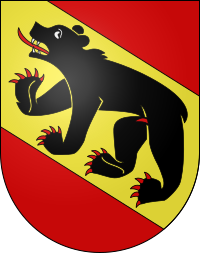Coat of arms of Bern

The coat of arms of Berne, both the city and the canton, is on a red field a yellow diagonal band charged with a black bear walking upwards toward the hoist. The heraldic blazon reads: Gules, on a bend or, a bear passant sable, langued, armed and vilene' of the field.
The flag of Berne is square and depicts the coat of arms. The heraldic colours of Berne are red and black. The heraldic beast of Berne is the Bear. The War Flag of the Ancien Régime, which shows a white cross on black and red flames, is also commonly encountered.
The Bernese Oberland also has its own flag, which is commonly encountered throughout the region. It shows a black eagle in a gold field (alluding to the region's old status as reichsfrei) over two fields in red and black, alluding to the region's affiliation with the Canton of Bern. A picture is available on the internet: Flag of the Bernese Oberland.
Heraldic beast

The bear has long served as namesake, emblem, mascot and — at times — personification of Berne. The founding legend has it that Duke Berchtold V of Zähringen vowed to choose as namesake the first animal his hunt met in the wood that was to be chopped down for the new city. Then, as Konrad Justingers chronicle puts it:
- Nu wart des ersten ein ber gevangen, darumb wart die stat bern genempt; und gab do den burgeren in der stat ein wappen und schilt, nemlich einen swarzen bern in einem wissen schilt in gender wise.
- Then they caught a bear first, which is why the city was called Bern; and so the citizens had their coat and shield, which was a black bear in a white shield, going upright.[1]
The bear motif is in evidence as early as 1224 (on city seals), and has remained in use ever since. Today the city of Berne still has bears featured directly outside its Altstadt in the Bärengraben.
Coat of arms

As Justinger's chronicle reveals, Berne's original coat of arms was an upright black bear on a white shield (which is, incidentally, the coat of arms of Berlin). Sometime during the 13th century, the coat of arms changed to the one in use today. The modern coat of arms is already recognisable in Alsatian mercenary songs of 1375 reported by Justinger. The change, according to the chroniclers, was linked to the Battle of the Schosshalde in 1289 against the troops of Duke Rudolf II of Austria, son of Emperor Rudolf II von Habsburg. According to Justinger, a Bernese salvaged a part of the ensign as the fortunes of war turned against Berne, and Tschudi recounts:
- Und als die von Bern bis ze der zit in ir paner den bern in wijssem veld gefuert, wars damals verendert in ein rot veld, von wegen das die paner ... von bluot was rot worden.
- Until then, those of Berne carried the white bear in a black field, but the field turned red that day, as the banner was drenched in blood.[2]
The chronicler Stumpf then adds that the diagonal band changed from silver to gold to celebrate the eventual Bernese victory over the House of Habsburg.

As long as Bern still considered itself (at least formally) to be part of the Holy Roman Empire, subject to the Emperor, this was reflected in its coat of arms. The imperial eagle was placed above the Bernese shield, constituting a compound coat of arms known as the Bern-Rych, or "Berne-Empire". Eventually, Berne formally gained the full sovereignty it had long since de facto possessed with the Peace of Westphalia in 1648, but it was not until 1700 that the eagle was replaced with the Republic's trefoil crown that signified ultimate temporal power.[3]
See also
- History of Berne
- Berlin, Berne's sister capital (of Germany), has a remarkably similar heraldic history.
References
Literature
Most of this article has been adapted from: Pascal Ladner, Siegel und Heraldik, in: Rainer C. Schwinges (ed.), Berns mutige Zeit: Das 13. und 14. Jahrhundert neu entdeckt, Bern, Schulverlag blmv AG und Stämpfli Verlag AG, Bern 2003, ISBN 3-292-00030-0 and ISBN 3-7272-1272-1, p. 244-245.
